AMD Entry-level PC
A year ago our entry AMD was single-core, last December 40% less money bought a 2.6GHz dual-core system, and today's AMD entry system uses a Black Edition unlocked 2.7GHz dual-core that costs a few dollars less than our choice just three months ago. That is certainly increased value in an economy that forces most buyers to look closely at price. With memory so cheap we have continued our recommendation of 4GB at a kit price of just $37. You can go with 2GB and save $18, but that money is well spent in doubling memory. The hard drive remains at 500GB.
| AMD Entry-level PC | ||
| Hardware | Component | Price |
| Processor | Athlon 64 X2 7750 Kuma 2.7GHz Black Edition (2.7GHzx2 95W 2x512KB L2) |
$60 |
| Cooling | CPU Retail HSF | $- |
| Video | On-Board | $- |
| Motherboard | ASRock A780GXE/128M 780G | $80 |
| Memory | G.Skill 4GB (2x2GB) DDR2-800 | $37 |
| Hard Drive | WD Caviar GP WD5000AACS 500GB | $60 |
| Optical Drive | Samsung 22X DVDRW/DL SH-S223Q | $25 |
| Audio | On-Board | $- |
| Case | SIGMA La Vie ABWBP Black Aluminum/ SECC ATX Mid Tower with 500W Power Supply | $60 |
| Power Supply | Included with Case | $- |
| Base System Total | $322 | |
| Display | Hanns-G HB-175APB Black 17" 8ms Widescreen LCD Monitor Built in Speakers - Retail (1440x900) | $99 |
| Speakers | Built into Monitor | $- |
| Input | Microsoft CA9-00001 Black PS/2 Standard Keyboard and Optical USB/PS2 Mouse - OEM | $16 |
| Operating System | Microsoft Vista Home Premium OEM | $99 |
| Complete System Bottom Line | $536 | |
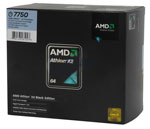 |
Prices on all processors are continuing to drop in the face of the aggressive pricing strategy adopted by Intel in entry to upper midrange processors. The $60 AMD 2.7GHz dual-core is a faster CPU at a slightly lower price than our December guide. Not only is it faster but it's also a Black Edition (unlocked) CPU. Most have been easily running at 3.0GHz just by increasing the multiplier. If you want even more power the Phenom 8750 triple-core Black Edition is a good value for just $44 more ($104). However, for most users the Athlon 64 X2 7750 provides plenty of power for an entry system. If you're counting pennies you could drop down to a single-core 2.6GHz Orleans 45W processor for $42 and save $18.
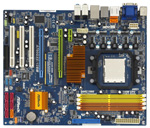 |
The 780G chipset is one of the best budget IGP designs we have worked with over the years. This is the chipset that made integrated graphics relevant again. One of the best boards in this price category is the ASRock A780GXE. The A780GXE features AMD/ATI Radeon 3200 integrated graphics. ASRock loads the board with six 3Gb/s SATA ports featuring RAID 0/1/10, 5.1 HD Audio, Gigabit LAN, two PCI-E x16 slots, one PCI-E x1 slot, three PCI slots, and support for 16GB of memory. Durability is addressed with solid capacitors for CPU power and duracap long-life capacitors for the rest. This board has been rock solid for us and supports AM2/AM2+ and the newest AM3 CPUs. The A780GXE has 128MB of sideport memory for additional performance. It fully supports the 140W Phenoms, and it can do dual x8 CrossFire. The A780GXE used to be a $100 board, so it is a good value at the current $80 price. It is ATX format, and ASRock also manufactures the A780FullHD motherboard, which at $57 may be a better choice for those pinching pennies. However, the extra performance of sideport memory and the better chipset for the $23 price difference is worth it in our opinion.
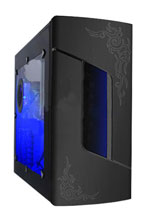 |
The case and power supply are the Sigma 500W La Vie mid-tower. This case and power supply are currently on sale after a $25 rebate for $40. Sigma makes both decent cases and decent power supplies that are sold separately. While no one will mistake this case/PSU combo for one of the premium Sigma offerings, it is still good quality and good value for a very reasonable price. Even if you pay the regular price of $60 to $65 you will get good value in this combo. We have built several entry systems with the Sigma case and PSU and had good results and stable performance. The only caveat is to check out the case when it arrives as shipping can take its toll on the case front door.
If you prefer a smaller case to mate with your Micro ATX motherboard the HEC 6K28BSOH48D Micro ATX mini-tower used in the Intel entry system is a good choice. It is a solid small case with a power supply from HEC, which is one of the world's best PSU makers. You should generally go for the best case and power supply you can reasonably afford, so you should also look at the cases and power supplies recommended for more expensive systems if you plan to keep your case/PSU and merely upgrade other components in the future.
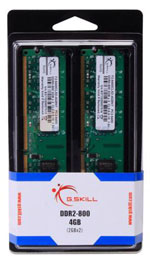 |
With DDR2 prices so very low, we went for 4GB of DDR2-800 this time. This is double last year's entry recommendation for less than half the price. This 50% to 75% drop in DDR2-800 memory prices in the past year is why you're not seeing much memory advertising these days. RAM prices as a whole are certainly in the commodity category as of late. We recommended the G.Skill 4GB DDR2-800 CAS 5 kit, but you could just as easily choose OCZ, Kingston, Corsair, Crucial, Geil, Patriot, A-Data or any other quality DDR2-800 name and shop for the memory based on a combination of price and the company's support reputation. Again, if you are truly pinching pennies you can save about $18 by going with a 2GB DDR2-800 kit instead at $19 to $20.
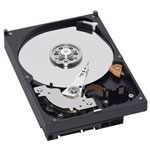 |
Hard drive capacity continues to grow, as you can see in our selection of the Western Digital Caviar 500GB for our entry system. It seems a waste to choose a lower HD capacity when 500GB is now available for around $60 - even from www.amazon.com. While there are differences between hard drives, outside of running benchmarks most people aren't likely to notice the difference in performance between Western Digital, Seagate, Samsung, Hitachi and other major brands. All are worthy of consideration if the price per gigabyte (or terabyte) is right.
 |
For the optical drive we went for value with the dependable Samsung 22X DVD. With the rise of the 25GB/50GB Blu-ray burners, DVD writers have continued to drop in price. A DVD writer that supports double-layer and 22X DVD writes for $25 is a bargain indeed.
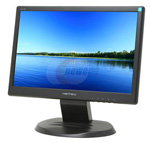 |
The last major component to discuss is the display, and here the tilt was toward price. $99 is a really low price for an LCD monitor, and the Hanns-G is a 17" widescreen that supports a native resolution of 1440x900. This is the resolution supported by most 19" and 20" widescreen monitors. You will not give up resolution with this monitor, but things will be a bit smaller.
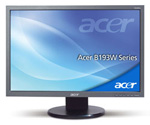 |
If your budget allows, you can choose the 19" Acer X193Wb with the same 1440x900 resolution at $120, or a 21.5" Viewsonic VX2233wm with true HD 1920x1080 resolution at $170. 21.5"/22" True HD is today's sweet spot, since the next step up to 23.6"/24" starts around $250. If your budget can stretch to $170, that is money well spent on a 21.5" 16:9 HD widescreen display.










66 Comments
View All Comments
7Enigma - Monday, March 16, 2009 - link
I think you're splitting hairs. Both of their Budget systems are fine for gaming if you add in a discrete graphics card. And in both system descriptions they mention adding a graphics card. Reading between the lines means add a graphics card and you have a gaming rig.Pretty simple.
frozentundra123456 - Monday, March 16, 2009 - link
With prices so low, I would say to include a mid-range graphics card such as the HD4670 with any system. The 4670 uses very little power and will improve video and allow decent basic gaming for less than 100.00 additional cost. It seems it is worth this even for the lowest end system which would still cost about 500.00 with monitor and OS and no graphics card.Hrel - Monday, March 16, 2009 - link
You can get a 640GB Hard Drive from Seagate with 32MB of cache, a 7200rpm speed and SATA connection for $60. So, 500GB or 640GB for $60? Hm, tough choice... sarcasm.MrSpadge - Saturday, March 21, 2009 - link
I agree, the systems should have faster HDDs! I'd choose the WD 640 GB 7200 rpm over the Seagate for speed. The WD green power has amazingly tuned firmware and it's faster than many elder 7200 rpm dirves, but it's not a magician and is held back by its 5400 rpm.Just think for a moment what limits the performance of a PC under "normal" use. What happens when you get to an elder machine, even with a healthy windows? Well, if you tell it to do anything you'll be greated by a constant "crrrrrrrr" from the HDD. Not the CPU or GPU is limiting, it's the HDD! That's why going with a 5400 rpm drive is almost silly.. you give up 15 - 20% speed and gain ~3W in power consumption. For the HTPC it's alright though, as it doesn't keep you from working if you have to wait for the HDD.
Hrel - Monday, March 16, 2009 - link
sorry, my bad, that drive is $70 now; it was $60 dollars like week ago though.AntiM - Monday, March 16, 2009 - link
I would say that 85% or more people could get by just fine with these machines. They are perfect for simple office machines. You could probably go even cheaper on the AMD system with an Athlon 64 X2 5600+ and 2 GB or RAM and still have plenty of horsepower for an office machine.Wesley Fink - Monday, March 16, 2009 - link
You can definitely go lower on the AMD CPU, but do you really think anyone would want to pay $67 for a 5600+ or 5600 Brisbane, when they can get a 7750 Kuma Black Edition for $7 LESS at $60. Pricing in entry space can be very strange.I also think dropping RAM from 4GB to 2GB is not very cost effective when you save just $17 by halving the RAM. If every penny counts I guess that that $17 could be important.
AgeOfPanic - Monday, March 16, 2009 - link
With the decoding capabilities of the current IGP chipsets why choose a Phenom processor with higher TDP over a Athlon X2 5050E?Penti - Tuesday, March 17, 2009 - link
A lot of people use homebrew (unlicensed) codecs for warez and their video watching. Those are usually software only or have a limited support for DXVA. Like many alternative media-portal/center software. If you don't want that flexibility there are other devices that even play warez that might fit your bill. But it's only commercial codecs that has decent hardware acceleration. You might also need the power for recording and encoding.7Enigma - Monday, March 16, 2009 - link
I think the answer is, "because we can". Honestly for a true HTPC the last article was fine, and nothing has really changed since then IMO. Yes you can for the same money get a more powerful system or even slightly cheaper, but the HTPC's job is not to be more and more powerful for the same/less money, it's to be cool and quiet while allowing for 1080p and all the resolutions below.Where the latest HTPC systems are beneficial is if you are using the HTPC box to rip or encode to different compressed formats while simultaneously watching something else, and/or recording multiple signals. Then it will be beneficial to have the Phenom II 3-core over a lowly X2.